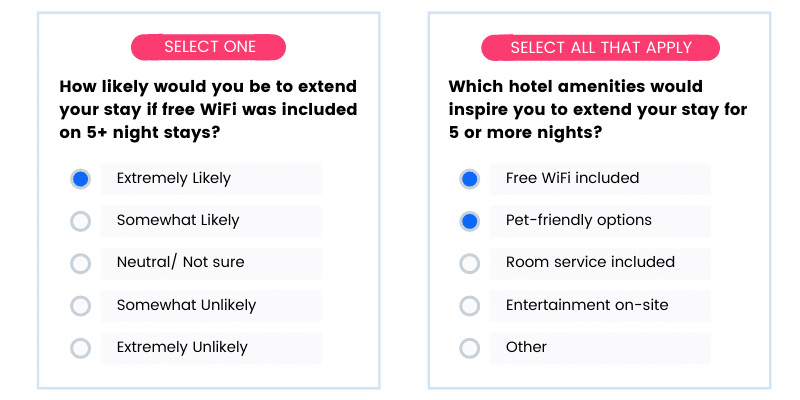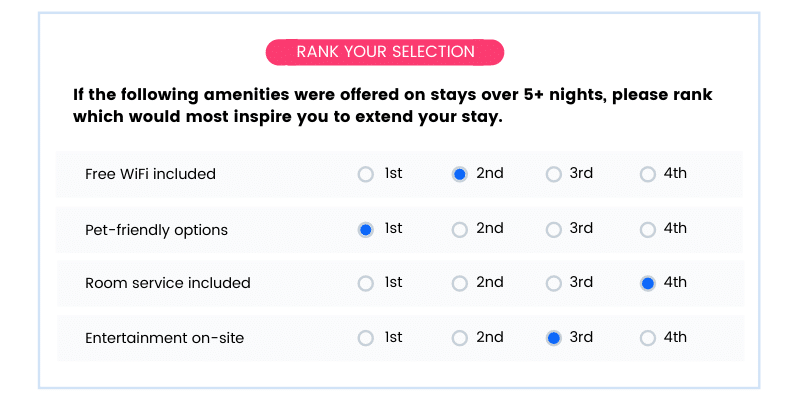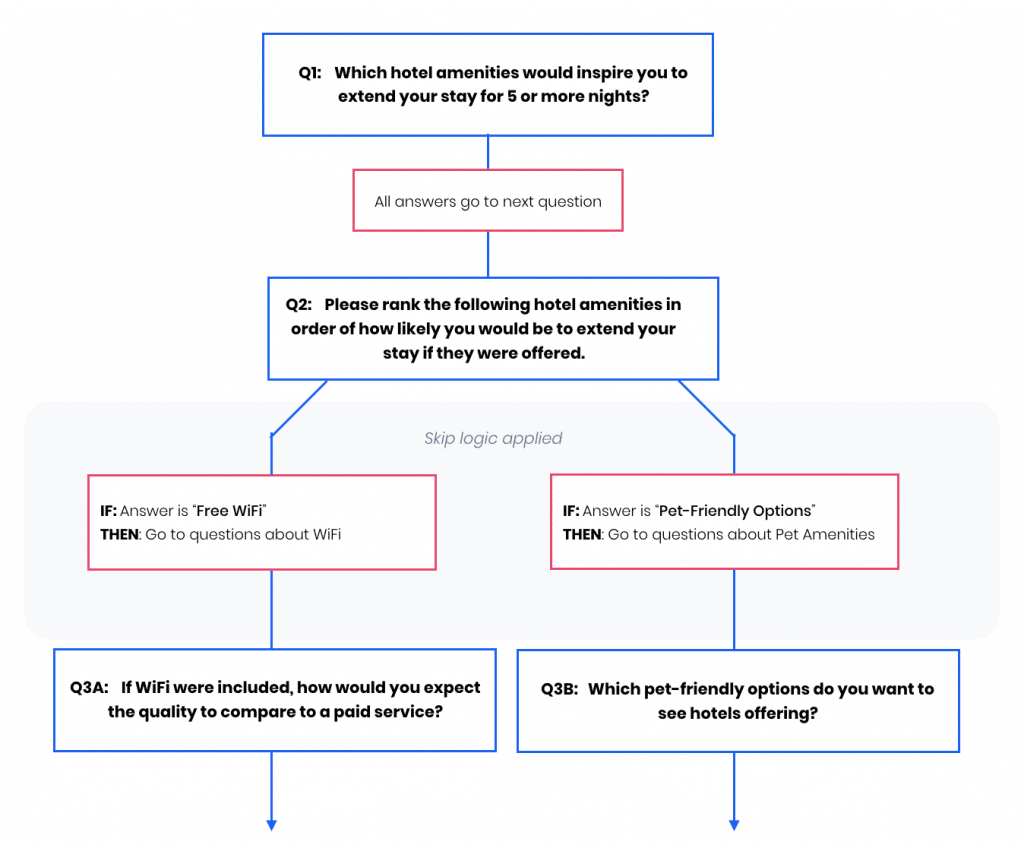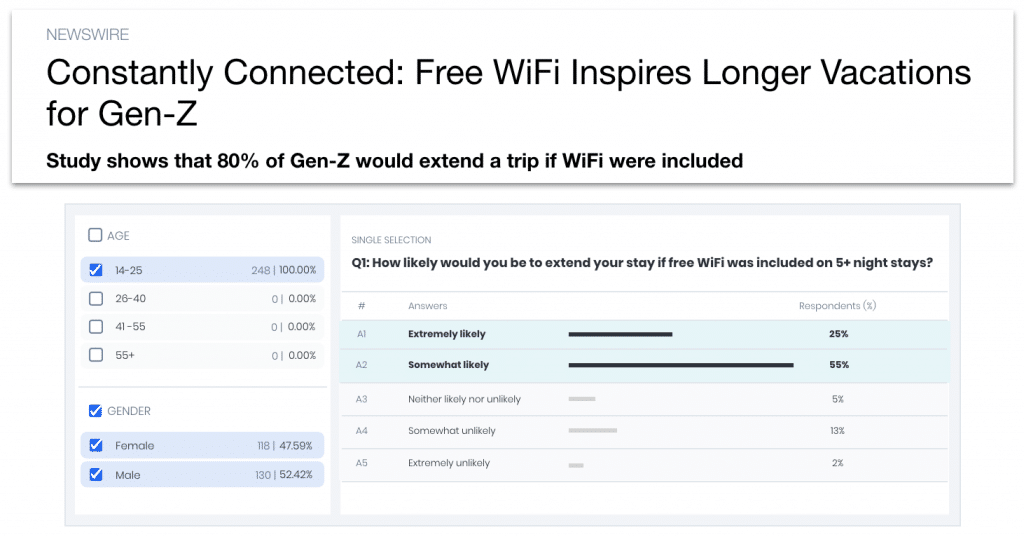How to create PR surveys for press coverage
Public Relations is one of the most effective ways for brands to build their credibility and brand awareness, but it can be challenging to get the coverage you want at a reasonable budget.

One way many brands are able to improve their PR efforts is to use consumer surveys. Consumer surveys are a great way for you to connect with a wide audience of your choosing, at a relatively low cost, to gain original insights that can spark exciting headlines and, if done correctly, consistent press coverage for your brand.
How to approach your PR Strategy
PR is a subtle, but effective way to gain press for your business, but many are unsuccessful because they attack it too directly. Self-serving pitches don’t work. Think a few levels deeper than simply telling a group of people about the thing you want them to know. Good PR relies on good storytelling.
For example, if you were a technology company releasing a new feature, you might want the editors at TechCrunch to cover it. However, if there isn’t a story behind the feature that appeals to the readers of TechCrunch, this is unlikely to be selected. A better strategy would be to pitch a journalist a story of how your new feature impacts their readers by demonstrating how it solves a problem, unveils an exciting new technology opportunity, or improves the market they are in—using data to back it up.
Like everyone else, journalists and PR professionals have their own target audiences to consider. When you pitch them your story, make sure you’re considering what would be the most interesting to their target audience that will help the journalist meet THEIR goals, whether that is article shares, pageviews or other metrics that they are likely using to gauge success.
Using PR Surveys to gain press coverage
PR surveys are a helpful tool in achieving press because they offer data that can help you discover trends or ideas that can be used to build your story and pitch. Original insights gathered from PR surveys give journalists an opportunity to be the first to break a story or offer an original angle, which is highly valuable to them.
They also offer credibility by providing a data-backed perspective to your discovery. With trust in the media being at a record-low 59% (according to Cision’s 2020 State of the Media Report), data can help journalists rebuild and regain that trust.
Some common ways that businesses use PR surveys to gain coverage include:
- “Newsjacking”—The act of piggybacking on hyper-relevant news such as elections, viral or trending content, or other highly-topical and visible subject matter by contributing new information related to the topic. It’s critical for businesses attempting this strategy to be able to quickly launch surveys, gain results, and interpret them as these topics tend to quickly appear and disappear from the news cycle.
- Ancillary topics— This is strategy lets businesses subtly, but consistently, get in front of potential buyers. They are able to use surveys to gather data around topics tangential to their services, which make more interesting stories and gain press coverage for their brand by proximity. An example might be a mattress brand running studies about how much sleep people like to get and what is preventing them from getting it.
- Trade insights—These tend to be market insights for an industry-specific audience and can have a wide reach within that sphere. When put into press-releases on a newswire, they also might garner attention from reporters covering national or global trade news. An example could be an automotive manufacturer announcing that their consumer research shows a 50% growth in demand for electric vehicles against last year’s data.
Best practices for creating PR Surveys
Start with a headline
As with all surveys, the most effective ones are those that begin with clear goals in mind. This can be challenging in a PR survey because the goal is the outcome, rather than the survey itself. One trick to help you get started is to consider what the ideal headline would be based on your survey results.
Say you work for a large hotel chain and you offer complimentary WiFi service on stays longer than 5 nights. Perhaps your ideal headline would be “Free WiFi inspires travelers to extend their stay.”
While this headline is yet to be verified, it gives you a hypothesis to work from and your survey can help you validate the truth behind this claim.
Use varied question types
Different question types help you gain different points of data. Recommended question types depend on your survey goals but ultimately should help create a story with your data that can be used in your outreach.
To continue with the hotel chain example, a question like “How likely would you be to extend your stay if free Wifi was included on 5+ night stays?” would support the desired headline, whereas “Which hotel amenities would inspire you to extend your stay for 5 or more nights?” where a respondent can select a series of features that they find valuable, could be a supporting data point. Both illicit important—but different—information in the story.

While a multiple-selection question might be the perfect way to determine a list of valuable features, a ranking question that positions the features as trade-offs is more valuable when comparing the features to each other, and offers yet another angle that might be interesting or supportive.

From the above examples, we know that the respondent would be extremely likely to extend their stay if WiFi were included, that they value free WiFi as well as pet-friendly options, and that given a choice between the two, pet-friendly options are actually a higher priority than the free WiFi.
Apply advanced skip logic
Skip logic is a feature offered by some consumer survey tools that allows you to create multiple paths for respondents to take depending on the answers they have previously given. It offers a more in-depth data-set and greater ROI on surveys to be able to investigate multiple angles at once.
Because the headline you are pursuing is a hypothesis, it is a good idea to offer more than one channel based on the answers respondents have given. This has the added benefit of extending your survey as well as gives you more data that could be used to create multiple angles and pitches.
 Tip!
Tip!
Keep in mind that advanced skip logic should be used to enhance the depth of your data by gaining more tailored insights, not as a way to run a series of completely separate surveys at once. This confuses respondents, diluting data quality. For example, if a respondent selects that they are much more likely to extend their stay if the hotel was pet friendly, it is appropriate to ask more questions about other things that support that information. It would not be a good time to test a new slogan for the hotel, which could result in confusing feedback or incorrect data correlation, such as “pet-owners do not like the new slogan.” It’s best to stay focused on the high-level survey goal you set at the beginning.
Interpreting your results
Oftentimes results from surveys can be as overwhelming as they are exciting. Depending on your experience with data analysis or your survey tool in particular, this can be one of the more time-consuming parts of the process, however, it is vital to making the previous steps worth your while.
Make sure to look at the individual answers to questions to see if anything pops out, as well as slice and dice the data to correlate different points to different groups. Depending on demographic information like age, gender, race, or geolocation, it’s possible that different groups will value different features more strongly than others. You can also compare people who answered a question one way with another answer they’ve given later in the survey to show the correlation between these responses.

In our hotel example, perhaps the headline wasn’t proven because your survey suggests that travelers are neither likely nor unlikely to extend their vacation for free WiFi. However, when you segment by age, you discover that a younger group is much more likely to factor this into their plans. At this time, you can adjust your headline to an accurate, data-backed statement.
How to write a press release with survey results
Once you’re done analyzing the data from your PR survey, you’ll likely have a pretty clear idea of what the “best” stories are. There can be more than one, and depending on who you’re reaching out to, “best” stories might vary. If you’re planning to reach out to individual journalists, it’s important to do some research into what their beat is ahead of time so you can tailor your pitch to their interests.
- Choose your lede
Even if you have more than one great thing to share from your survey, you need to select one to be the primary hook for your press release or outreach. Ultimately, you want the most interesting piece of information to be the lede, using the rest of your data as supporting and supplemental information.
- Keep it simple
A long list of stats that share everything you uncovered in your survey might be exciting for you, but is likely too much information for the average reader. Stick to one angle per press release/ pitch and create more pitches with different angles if you have the data to do so. This has the additional benefit of reaching more audiences with different interests and improving the ROI of your survey.
In our hotel example, perhaps your survey revealed two great ledes: 80% of Gen Z would extend their stay for free WiFi, and that people would be 3x as likely to take more vacations if they could bring their dog. You can write these as two uniquely interesting stories and pitch to different outlets that would find these of interest.
- Use data in your headline
Leading with an impressive stat immediately builds credibility and catches attention. The news aims to provide new information, so an exciting stat revealing a new idea or data disproving a common belief are always exciting headlines. The more controversial or unexpected the findings, the better!
- Include your research methodology
According to Cision’s 2020 SOTM report, nearly 20% of journalists cite combating “fake news” as a challenge. Data can often come under fire when its veracity is doubted, so its best to use a reputable tool to back up your claims. Know a little bit about the survey methodology your survey partner is using to collect data and ensure that they have a good system for survey fraud prevention, as well as being able to provide a representative sample of your target audience.
- Offer exclusivity when you pitch
Being the first to break news is still attractive to journalists, who want to report on new information—not syndicate what already exists. Offering the same story to all of their competitors dilutes the potency of your news. If you’re doing individual outreach, select your journalist carefully and let them preview your press release under embargo before it goes live. Make sure to mention that you’re offering it as an exclusive to them, but also mention when you plan to publish it to the newswire to give them a deadline to decide.
If you’re looking for more great resources on using surveys in creative ways, be sure to check out the Pollfish Resource Center, or reach out to our 24/7 customer experience team for guidance and support.
Ally
Ready to Try Pollfish?
Create your survey with AI, target high-quality respondents starting at $0.95 per complete, and start getting results in just minutes in real-time. From running a simple product concept survey to managing a constant stream of trackers for dozens of clients in dozens of countries, we’ve got you.
